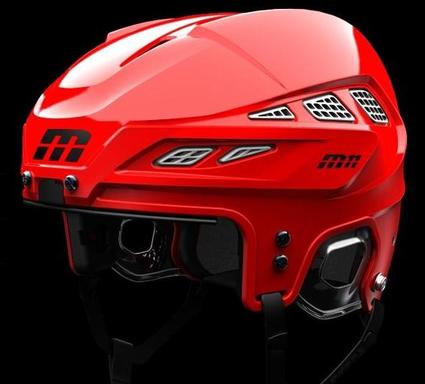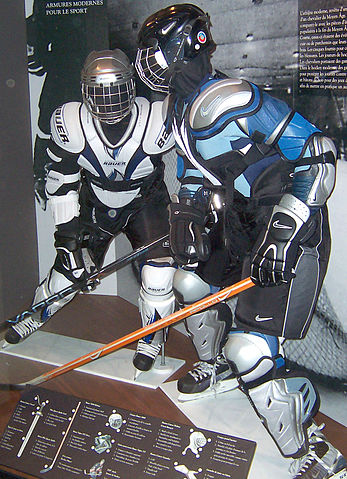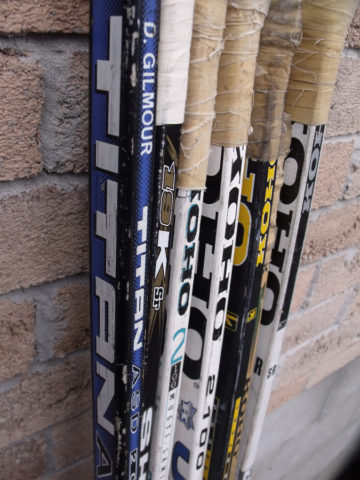Despite the Coronavirus pandemic, youth hockey players have continued to grow. And in many cases, they’ve outgrown the hockey equipment they were using just a few months ago. One way to economically re-equip young players is an “equipment swap.” Typically organized by and held at an ice rink, a day (or weekend) is set aside for parents to buy and sell gear. In some areas, gear swaps are held a couple of times a year, most often just before the start of a new session.

While it would be great to buy brand-new gear for each kid in the family every season (and for each sport in which each kid participates), that can get incredibly expensive. And don’t forget that it takes some time for equipment to get broken in properly. Buying new every few months may not be doing your child any favor, no matter how quickly he or she is growing.
For the Starter Parent
If your child is new to hockey and needs to start from the skates up (so to speak), you might spend between $500 and $700 for top-quality brand-new gear. But that’s hardly the only way to go. Remember, too, that if your child is just starting with a sport, it might not stick (again, so to speak). You might discover that after just a few months – or even weeks – your youngster’s fascination with hockey was more of a fantasy and they have quickly moved on.

If you are a new hockey parent, you’ll find an excellent description of the gear needed and what should be purchased new and what can be second-hand at NewToHockey.com. That page includes in-depth descriptions of equipment, as well as links to excellent additional information about each piece of gear. If you want a somewhat scary look at the cost of youth hockey, try this link.
What is an Equipment Swap?
During the semi-controlled mayhem of an equipment swap, parents (with the help of their older kids, friends, and parents of teammates) have two goals: to sell equipment that no longer fits their young hockey player, and to purchase appropriate used equipment from other parents.
Related: Hockey 101: Ice Hockey Equipment
Not all kids get to participate in equipment swaps – some families have multiple young players and hand-me-downs become the norm for all but the oldest.
Parents, however, need to ensure that gear passed from child to child not only is still serviceable but is also appropriate for the recipient. “Oh he (or she) will grow into it” is an oft-heard comment, but that statement carries a certain amount of risk. Gear that’s too large (or small) for a young hockey player can lead to avoidable injuries. And pieces that have been in the family for too many years may no longer provide the amount of protection they once did.
The Nuts and Bolts of a Swap
One facility that holds an annual youth equipment swap is the Ice Box Skating Rink in South Bend, Indiana. The event is usually scheduled for a Saturday morning prior to the start of the fall season. Parents who choose to participate, follow these steps:
- Register for the Swap. A non-refundable $5 fee is charged to offset the cost of the event. The signup is done through the youth league’s website.
- Receive a registration number. Each participant is assigned a unique number. During the swap, the registration numbers assigned to each family are used to ensure that they receive the appropriate compensation for their equipment that did sell.
- Create equipment tags. The organizer sends a form that can be used to create tags for each piece of equipment for sale. The tag includes cost, size, and description.
- Clean the gear. It’s more likely to sell if a piece of equipment is in the best shape possible.
- Bring the gear to the swap. And then prepare for the milling about as parents try to find the most appropriate gear at the best prices.
The equipment tags at the Ice Box have another field: “Donate Yes/No.” Brian Troester is the president of the Irish Youth Hockey League, which is based at the Ice Box and sponsor of the swap. He says “If a piece of equipment doesn’t sell during the swap, a lot of people will donate it to the IYHL for players who can’t afford equipment.”
Why You Should Attend an Equipment Swap
One advantage of an equipment swap is that (typically) the youngsters accompany their parents and can try on the gear to ensure a proper fit. (Tip: If skates are on the shopping list, make sure the kids are wearing the same socks that they’ll have inside those skates on the ice.)
Related: Return to Hockey: Lessons Learned from Jacksonville
In addition to the in-person swaps, such as that at the Ice Box, there are online swaps available. While you won’t have the chance to inspect the gear or have your child try it on for fit, some great deals can be found. Among the online swaps, which typically run year-round, are SportsEngine’s MentorYouthHockey.com and SidelineSwap (which is not limited to hockey or youth gear).

Of course, in addition to the procedure used by the Irish Youth Hockey League and the online swaps, there are other options. Here’s one additional take on gear swaps, courtesy of VeryWellFamily.com.
One final note: Our area has experienced an exponential growth in youth hockey over the past several years. Along with that explosion of young players has come a great increase in adult hockey players, both men and women. Many are parents of youngsters who see their kids play and decide to get involved themselves.
Related: How to Talk Like a Hockey Player
In some cases, they simply get hooked on hockey while watching the kids play and practice. In other cases, a parent may attend a Learn-to-Play clinic (or several) simply in order to be able to better discuss the game over the dinner table. When just starting out, dads and moms can buy used equipment, too.